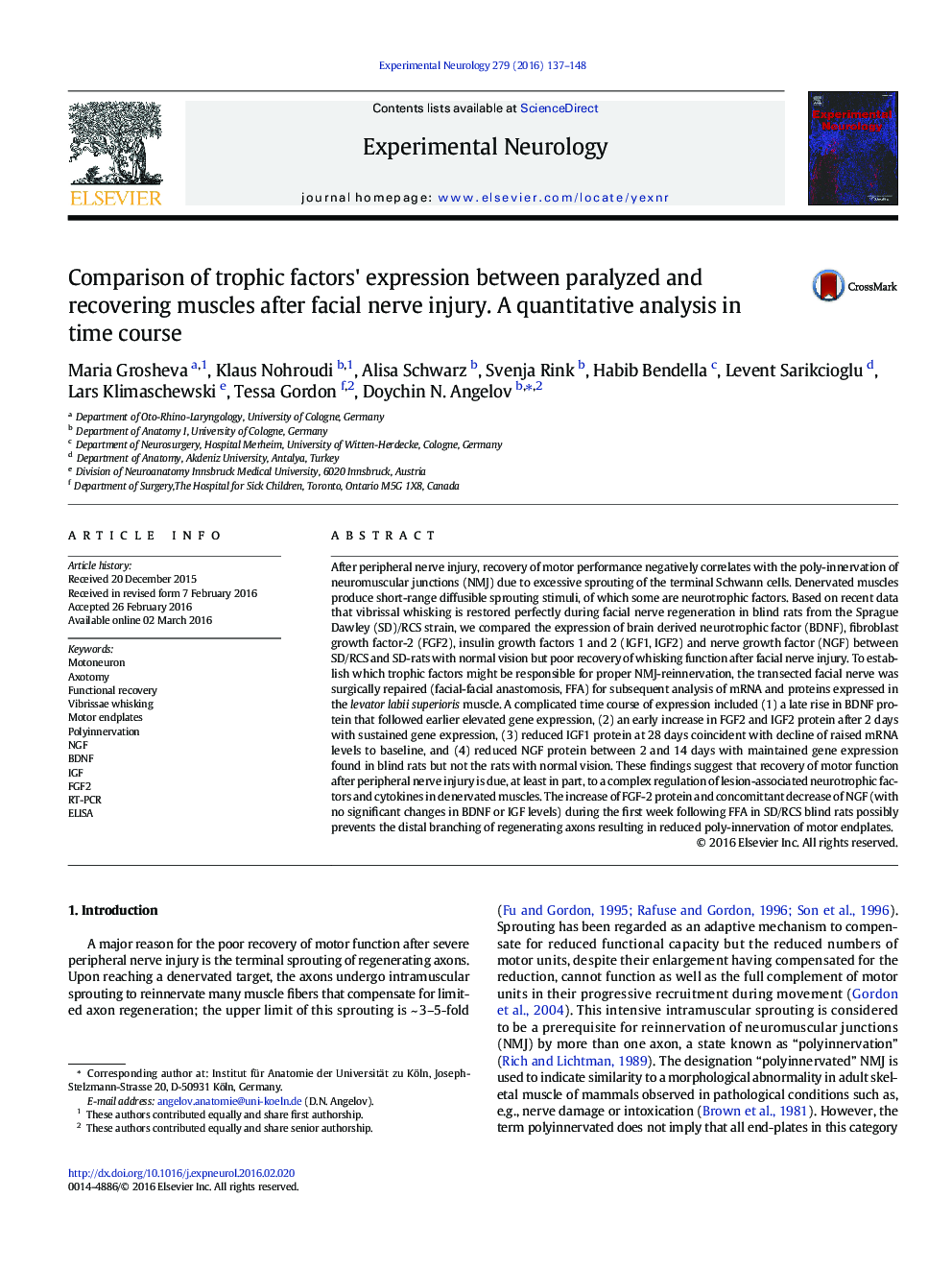| کد مقاله | کد نشریه | سال انتشار | مقاله انگلیسی | نسخه تمام متن |
|---|---|---|---|---|
| 6017033 | 1580156 | 2016 | 12 صفحه PDF | دانلود رایگان |
عنوان انگلیسی مقاله ISI
Comparison of trophic factors' expression between paralyzed and recovering muscles after facial nerve injury. A quantitative analysis in time course
ترجمه فارسی عنوان
مقایسه بیان فاکتورهای تروفی در بین عضلات فلج شده و بهبودی پس از آسیب عصب صورت. تجزیه و تحلیل کمی در زمان
دانلود مقاله + سفارش ترجمه
دانلود مقاله ISI انگلیسی
رایگان برای ایرانیان
کلمات کلیدی
موضوعات مرتبط
علوم زیستی و بیوفناوری
علم عصب شناسی
عصب شناسی
چکیده انگلیسی
After peripheral nerve injury, recovery of motor performance negatively correlates with the poly-innervation of neuromuscular junctions (NMJ) due to excessive sprouting of the terminal Schwann cells. Denervated muscles produce short-range diffusible sprouting stimuli, of which some are neurotrophic factors. Based on recent data that vibrissal whisking is restored perfectly during facial nerve regeneration in blind rats from the Sprague Dawley (SD)/RCS strain, we compared the expression of brain derived neurotrophic factor (BDNF), fibroblast growth factor-2 (FGF2), insulin growth factors 1 and 2 (IGF1, IGF2) and nerve growth factor (NGF) between SD/RCS and SD-rats with normal vision but poor recovery of whisking function after facial nerve injury. To establish which trophic factors might be responsible for proper NMJ-reinnervation, the transected facial nerve was surgically repaired (facial-facial anastomosis, FFA) for subsequent analysis of mRNA and proteins expressed in the levator labii superioris muscle. A complicated time course of expression included (1) a late rise in BDNF protein that followed earlier elevated gene expression, (2) an early increase in FGF2 and IGF2 protein after 2Â days with sustained gene expression, (3) reduced IGF1 protein at 28Â days coincident with decline of raised mRNA levels to baseline, and (4) reduced NGF protein between 2 and 14Â days with maintained gene expression found in blind rats but not the rats with normal vision. These findings suggest that recovery of motor function after peripheral nerve injury is due, at least in part, to a complex regulation of lesion-associated neurotrophic factors and cytokines in denervated muscles. The increase of FGF-2 protein and concomittant decrease of NGF (with no significant changes in BDNF or IGF levels) during the first week following FFA in SD/RCS blind rats possibly prevents the distal branching of regenerating axons resulting in reduced poly-innervation of motor endplates.
ناشر
Database: Elsevier - ScienceDirect (ساینس دایرکت)
Journal: Experimental Neurology - Volume 279, May 2016, Pages 137-148
Journal: Experimental Neurology - Volume 279, May 2016, Pages 137-148
نویسندگان
Maria Grosheva, Klaus Nohroudi, Alisa Schwarz, Svenja Rink, Habib Bendella, Levent Sarikcioglu, Lars Klimaschewski, Tessa Gordon, Doychin N. Angelov,
